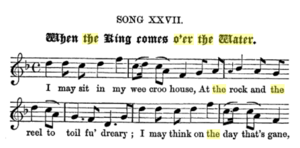Mary Drummond facts for kids
Mary Drummond (1675 – 1729) was an important supporter of the Jacobites. These were people who wanted to bring a Catholic king back to the British throne. She became known as Mary, Countess Marischal in 1694. While a famous song called When the King Comes O’er the Water is sometimes thought to be written by her, it's actually written from her point of view.
Quick facts for kids
Mary Drummond
|
|
|---|---|

Somg written in her voice about her plight
|
|
| Born | 14 July 1675 Kingdom of Scotland |
| Died | 7 March 1729 Edinburgh |
Early Life and Family
Mary Drummond was born on 14 July 1675 in the Kingdom of Scotland. Her father was James Drummond, 4th Earl of Perth. Her mother was Lady Jane Douglas. Mary's grandfather on her mother's side was William Douglas, 1st Marquess of Douglas.
Mary's father, James Drummond, was a strong supporter of the Jacobites. Because of his beliefs, he was put in prison in December 1688. He was later sent away from the country in 1693. Mary was already married by this time.
Marriage and Children
Around 1690, Mary Drummond married William Keith. He later became the 9th Earl Marischal in 1694. His father was George Keith, 8th Earl Marischal. His mother was Lady Mary Hay.
Mary and William had several children. Their oldest son was George Keith, 10th Earl Marischal. He was born in 1692 or 1693 and became the last Earl Marischal. Their other son, James Francis Edward Keith, was born in 1696. He was named after the "Old Pretender," who was the person the Jacobites believed should be king. Both of Mary's sons became soldiers.
Mary and William also had two daughters. Their daughter Mary married John, the sixth Earl of Wigtown. Their daughter Anne married Alexander, the sixth Earl of Galloway.
Mary Drummond passed away in Edinburgh on 7 March 1729. She was buried at Holyrood Abbey.
The Song: When the King Comes O’er the Water
The song When the King Comes O’er the Water is often linked to Mary Drummond. However, she did not actually write it. Experts believe the song was created after she died. It was first printed in a book called Jacobite Relics by James Hogg in 1817.
Even though Mary didn't write the song, it tells a story from her point of view. The song ends with these lines: "My faither was a guid Lord’s son, my mither was an Earl’s daughter / And I will be Lady Keith again, the day oor King comes o’er the water".

